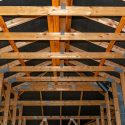Embarking on a roofing project can be a daunting task, especially when deciding the type of structural framework to use: rafters and trusses. Both have their unique advantages and applications, and it helps to know the difference between the two. This blog post will delve into the distinctions between roof rafters and trusses, helping homeowners make informed decisions tailored to their needs.

Understanding the Basics: Rafters vs. Trusses
Roof rafters and trusses serve the same fundamental purpose – supporting the roof of a building. However, their design, construction, and installation processes significantly diverge.
- Rafters are traditional, crafted on-site, and assembled piece by piece. This method offers flexibility and is often the go-to choice for custom designs.
- Trusses come as a pre-engineered, prefabricated unit, ensuring quick assembly and a more cost-effective method for straightforward roofing projects.
The Flexibility and Customization of Rafters
For homeowners looking for a distinctive touch or dealing with unique architectural features, rafters might be the way forward. Their on-site assembly allows for greater design flexibility, accommodating various shapes and styles. This method is particularly advantageous for custom or complex roof designs that require bespoke solutions. However, this customization comes at a cost, both in terms of time and budget, as it demands skilled labor and intricate craftsmanship.
Trusses: Streamlining Roof Construction
On the other hand, trusses offer a more streamlined approach to roofing. Manufactured in a controlled environment using precision technology, trusses are designed for quick installation. This not only speeds up the construction process but also reduces labor costs significantly. Trusses are often the preferred choice for new constructions due to their efficiency and the fact that they don’t require interior load-bearing walls, allowing for more open floor plans.
Factors To Consider
When choosing between the two, there are a variety of factors that must be considered:
- Cost. As previously mentioned, trusses can lead to substantial savings on labor and time, making them an attractive option for budget-conscious homeowners. However, the initial cost of prefabricated trusses can be higher than purchasing lumber for rafters. It’s essential to consider both the direct costs and the broader financial implications of each option, including the potential for longer construction times with rafters and their impact on overall project cost.
- Longevity and Structural Integrity. When it comes to the long-term performance and durability of your roof, both rafters and trusses have proven to be reliable. However, the engineered precision of trusses can provide additional peace of mind in terms of structural integrity, especially in areas prone to harsh weather conditions. The prefabrication process ensures consistent quality and adherence to building codes, making trusses a safe choice for homeowners concerned about the longevity of their roofing system.
In conclusion, whether you opt for the traditional charm and customization potential of rafters or the streamlined efficiency and cost benefits of trusses, your decision will have a lasting impact on the functionality and aesthetic of your home. Lask Exterior Solutions, LLC in Rockford, IL, is here to help guide you through this critical choice, ensuring that your roofing project is a resounding success. Call us at (815) 964-2220, or complete our online form for a free quote. We work with clients in Rockford, IL, and nearby communities.
